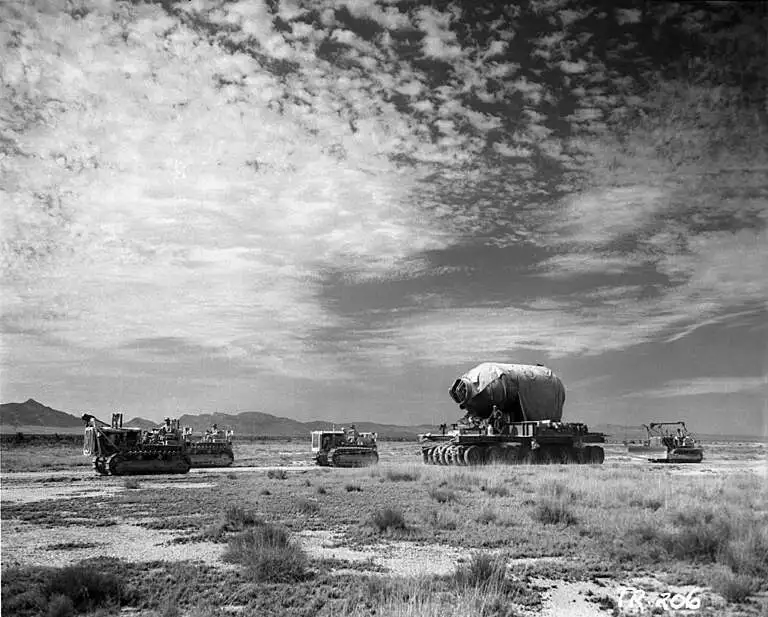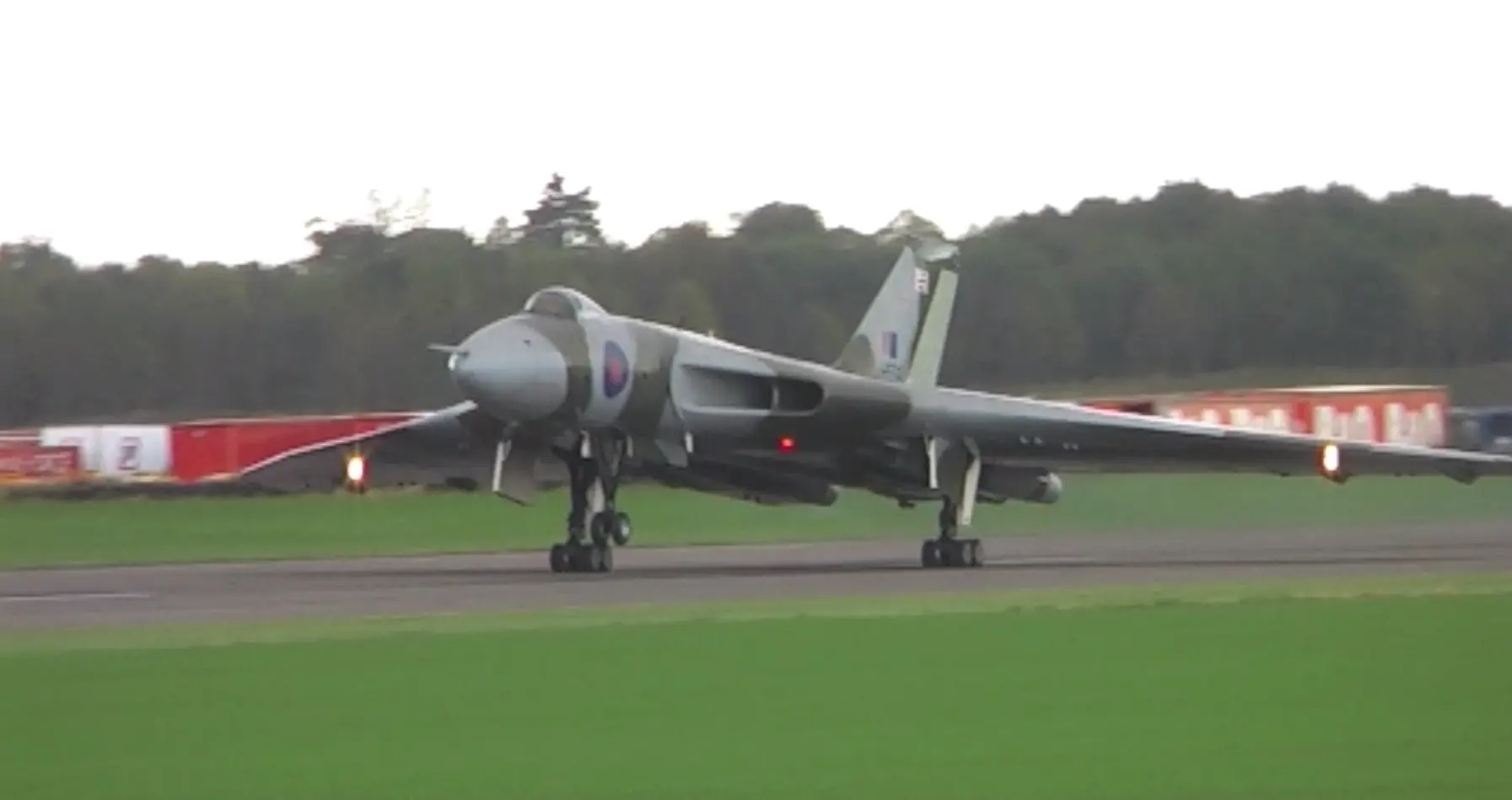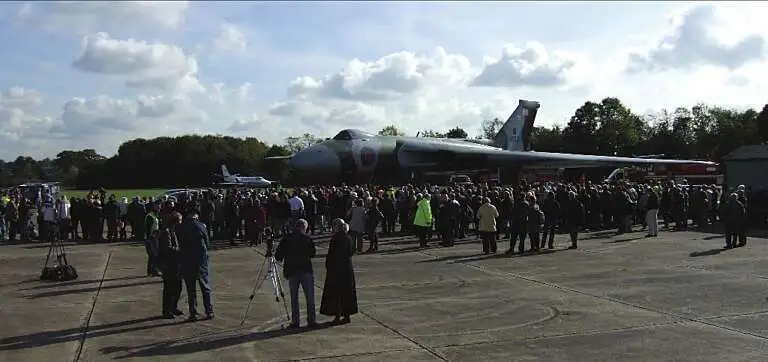
Britain’s Nuclear Deterrent Development – Part Four
On 8 May 1945, Winston Churchill announced German armed forces had surrendered unconditionally. But, the World War had not completely ended. In his speech announcing

With funds now in place to take XH558 to first flight the team threw themselves back into the final stages of rectification. The aircraft went back on jacks for the completion of Mod 2222, and to speed the work more logistics staff were brought in, housed in a new office built in the hangar. As 2006 became 2007 parts were now flowing back from OEM’s, including BF Goodrich who accounted for 84 different products, five of which were flight safety critical. Amongst these were the chassis mounted fuel systems for the Olympus engines, the refurbishment package accounting for some 250 man hours. The test rig for the system had been on the verge of being scrapped before XH558’s restoration!
Work on the fuel tank skins had come to an end, so the bladder cells and pumps could be installed (not a simple task when there are fourteen separate tanks). As the cells weren’t rigid enough to be simply pushed through the access panels there had to be someone inside the tanks to manoeuvre each cell into place, a hot and confined task. The hydraulic system had been rebuilt, so all the pipes now had to be flushed through, first with Altrans (a phosphoric acid), then demineralised water, and finally blown through with nitrogen to dry them out. That done, the system was ready for functional testing. The huge, 23 feet long jet pipes could also be reinstated, although having been out of the aircraft for 6 years there was little corrosion to be treated, just the rollers that would carry them into the pipe tunnels needing to be lubricated.
It had been hoped that XH558 would return to flight in time for at least some airshow appearances in 2007, and indeed that she might take part in the Falklands 25th anniversary flypast over London on June 17th, with the engineering team working flat out to meet the deadline. Any chance of this was scuppered though, as unexpected areas of corrosion were discovered in both wings. An unwelcome and expensive delay, that would cost 3 months and all the remaining contingency cash. Reaching and treating the corrosion (on the beams and stringers supporting the wing structure) meant peeling back large areas of skinning on the upper wing surfaces, removing some 25,000 rivets on each side!
Some compensation for the disappointment came with a visit to the hangar by Baroness Thatcher, (on the anniversary of XH558’s arrival at Bruntingthorpe), who would meet some of the Black Buck crew. Acknowledgement of the project’s achievements also came from the Transport Trust who presented their annual “Preservationist of the year” award to Dr Robert Pleming. VTST also later won the Worshipful Company of Engineers Heritage Engineering Award for 2008.
Despite the setback caused by the stringer corrosion, there was a feeling that the long-awaited day was drawing close, as the list of remaining tasks inexorably shortened. The rudder and elevons returned from Beagle Aerospace and were carefully craned into place. Several of ‘558’s original elevons had been too badly corroded for economic repair, but fortunately the VTST had spares which were recoverable, though still needing refurbishment at Beagle’s premises. The cockpit was reassembled, with the addition of several modern avionic systems. An electrical test bay for instruments had been custom built in a room above the hangar, and as gauges and indicators returned from Serco at Cranwell, they could be finally checked before being returned to the aircraft. In the bay the cockpit instrument panels were reassembled, and other electrical tasks completed like testing the 500 watt landing lamps. With power on fast approaching, it was also the turn of the Air Electronics Officers (AEO’s) to undergo refresher training on all the major circuit diagrams in preparation for operating the aircraft.
With corrosion repairs almost at an end final electrical inspections were made in the engine bays, and finally four zero-timed Rolls-Royce Olympus 202 engines (in store since 1982) were one by one winched into place. It was anticipated that each engine would have an on-wing life of seven years, and the plan was to rotate the use of the eight available engines to ensure even wear and maximise operational life. Fitting the engines required a team of six technicians, (team leader, second-in-command and four to operate the hand winches). With the winch operators in place the team leader directed the lifting of the engine, while the second-in-command observed from the air intake bay, ensuring the engine was square with the locating channels. Once the engine was in position the leader and second- in-command fitted the three locking pins that secured it in place.
Bomb bay doors and undercarriage were refitted, and a 476lb steel weight (nicknamed the ‘Red Slab’) went into the radome in place of the H2S radar. The fuel system was pressure tested for leaks, and ‘558 was rolled out to take fuel on board once more. The port No. 2 tank was found to leak though, and the punctured cell had to be drained, removed and returned to the OEM. In the meantime hydraulic tests could be carried out, including undercarriage retraction and bomb door operation. The pneumatic emergency blow-down system was also successfully tested. In the event of a hydraulic failure the undercarriage is lowered by blowing pressurised nitrogen through the hydraulic pipes, but as this displaces all the hydraulic fluid the groundcrew were ready with strategically placed buckets! Forward ejector seats and rear crew seats arrived and were fitted, and the renovated and resprayed cockpit canopy replaced – the aircraft was now looking whole and ready for action.
After extensive system checks, XH558 rolled out again on August 16th, and was towed down to the ground running pan, where her engines were started for the first time and run up to idle speed. Full power runs of all four engines followed several days later. A further two months of testing on the ground saw the flying control systems set up, and forced deflection tests performed on rudder and elevons to check the artificial feel units were functioning correctly.
As October arrived, so did the flight crew to carry out slow and fast taxi runs. Whilst the Test Flight was to be performed under Marshall’s own approvals, the Test Pilot was to be Al McDicken, a graduate of the Empire Test Pilot School and former Vulcan pilot, with over 10,000 hours on some 90 aircraft types. The first taxi took ‘558 up to 30 knots, to bed in the brakes and run through all system functions. A few snags were thrown up, but quickly fixed, and the next day saw high speed taxying, with the giant brake parachute deployed. With all remaining tasks complete and the last job cards cleared, the final documentation could be signed and stamped, releasing XH558 for flight tests. First flight was now inevitable.

On 8 May 1945, Winston Churchill announced German armed forces had surrendered unconditionally. But, the World War had not completely ended. In his speech announcing

Barry Masefield was the Air Electronics Officer (AEO) for Vulcan XH558 and had flown in this iconic aircraft for over 30 years, also being a key

Thursday 18th October 2007 dawned, a perfect day for flying, and destined to be an unforgettable one. Anticipation was keen as the media and invited

Barry Masefield was the Air Electronics Officer (AEO) for Vulcan XH558 and had flown in this iconic aircraft for over 30 years, also being a key